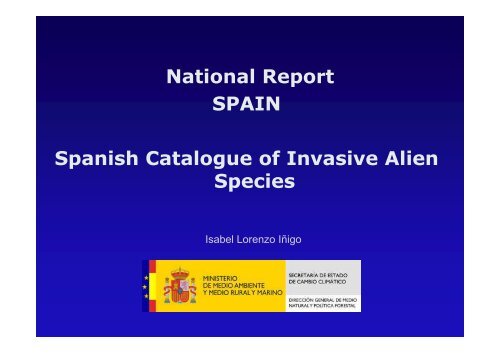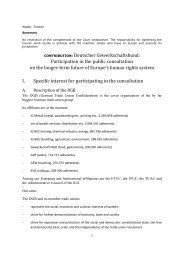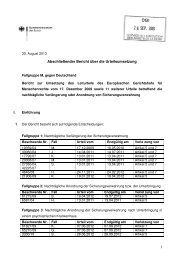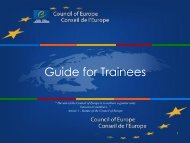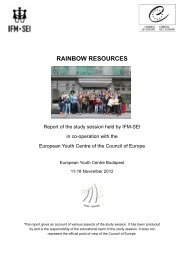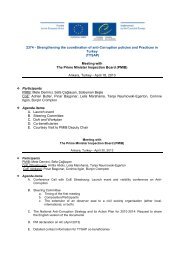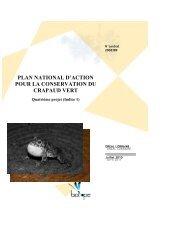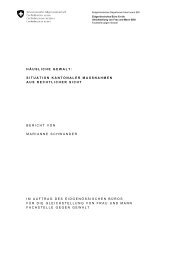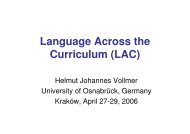National Report SPAIN Spanish Catalogue of Invasive Alien Species
National Report SPAIN Spanish Catalogue of Invasive Alien Species
National Report SPAIN Spanish Catalogue of Invasive Alien Species
Create successful ePaper yourself
Turn your PDF publications into a flip-book with our unique Google optimized e-Paper software.
<strong>National</strong> <strong>Report</strong><br />
<strong>SPAIN</strong><br />
<strong>Spanish</strong> <strong>Catalogue</strong> <strong>of</strong> <strong>Invasive</strong> <strong>Alien</strong><br />
<strong>Species</strong><br />
Isabel Lorenzo Iñigo
Index<br />
• Current situation<br />
– Law 42/2007 on Natural Heritage and Biodiversity<br />
– <strong>National</strong> Projects<br />
– 3 Strategies<br />
– Regional Communities<br />
• Future situation<br />
– <strong>Spanish</strong> <strong>Catalogue</strong> <strong>of</strong> <strong>Invasive</strong> <strong>Alien</strong> <strong>Species</strong>
Current situation<br />
Law 42/2007, 13th December, on the Conservation <strong>of</strong> the<br />
Natural Heritage and Biodiversity, the major legal corpus in<br />
nature conservation<br />
• Article 52.2 – Public administrations<br />
will ban the introduction <strong>of</strong> species,<br />
subspecies or breeds when they are<br />
subject to compete with wild indigenous<br />
species, modify its genetic purity or the<br />
ecological balances.<br />
• Article 61 - Creates the <strong>Spanish</strong><br />
<strong>Catalogue</strong> <strong>of</strong> <strong>Invasive</strong> <strong>Alien</strong> <strong>Species</strong><br />
• Article 62.3.e – In relation to fishing<br />
and hunting activities it is forbidden the<br />
introduction <strong>of</strong> exotic species
Current situation<br />
With the actual regulatory framework the main activities are<br />
centralised in specific projects.<br />
In coordination with the regional authorities, the <strong>Spanish</strong><br />
Ministry <strong>of</strong> Environment, Rural and Marine Affairs continues<br />
with the implementation <strong>of</strong> national or local projects.<br />
• <strong>National</strong> control <strong>of</strong> Ruddy duck (Oxyura<br />
jamaicensis) – Conservation Strategy <strong>of</strong><br />
White headed-duck (Oxyura leucocephala)<br />
• Control <strong>of</strong> American mink (Mustela vison)<br />
in areas where the European mink, one <strong>of</strong><br />
the most endangered carnivore species in<br />
the world, is present – Conservation Strategy<br />
<strong>of</strong> European mink (Mustela lutreola)<br />
Additionally, a<br />
number <strong>of</strong> projects<br />
implemented with<br />
LIFE financial<br />
support address the<br />
IAS management
Current situation<br />
Dedicated budget lines <strong>of</strong> the Ministry for 2010:<br />
• Conservation project <strong>of</strong> European mink Mustela lutreola<br />
and management <strong>of</strong> American mink Neovison vison<br />
populations.<br />
• <strong>National</strong> Water Basins<br />
- Management and restoration projects for the<br />
Dreissena polymorpha, Eichornia crassipes, Procambarus<br />
clarkii and alien fish species.<br />
- Zebra mussel <strong>National</strong> Control Strategy
Current situation<br />
Actions for the control <strong>of</strong> American Mink – Since 2003 > 3000<br />
individuals<br />
Burgos, Álava, La Rioja, Navarra, Soria, Palencia, Segovia, Cataluña, Teruel,<br />
Zaragoza, Castellón, La Coruña y Lugo.<br />
GENERAL OBJECTIVE:<br />
Support Biodiversity in rivers and wetlands<br />
SPECIFIC OBJECTIVES:<br />
Remove invasive species populations within the<br />
area <strong>of</strong> European mink distribution.<br />
Population control <strong>of</strong> feral American mink out <strong>of</strong><br />
the influence area <strong>of</strong> the native species.<br />
© WWF/Adena<br />
WITH OUT THIS WORK – EXTINCTION OF EUROPEAN MINK-
Current situation<br />
Legislation:<br />
Regional Communities<br />
- Valencia: Law – Decree 213/2009, 20th November, by which IAS control measures in<br />
Valencia Regional Community are approved<br />
- Castilla la Mancha: The species declared as IAS are Ameiurus melas, Ictalurus<br />
punctatus, Silurus glanis, Pacifastacus leniusculus, Procambarus clarkii, Alburnus<br />
alburnus, Gobio gobio, Leppomis gibosus and Sander Lucioperca<br />
Programs:<br />
- Andalucía: Andalucian Program for IAS control<br />
Projects:<br />
- Baleares Islands: Actions on IAS - Pennisetum villosum, Pennisetum setaceum,<br />
Eichornia crassipes, Cotula coronifolia, Carpobrotus, Hydrocolite bonariense,<br />
Limonium, Estrilda astrild, Procyon lotor, Nasua nasua, Myiopsitta monachus, Podarcis<br />
simula.<br />
Also: Rodent eradication in Sa Dragonera (260 hectares), rattus rattus and mus musculus have<br />
been eradicated, captures <strong>of</strong> feral pigs and pigs hybridized with wild boar (Sus scr<strong>of</strong>a) and feral<br />
goats.<br />
…
Future situation<br />
Law on the Conservation <strong>of</strong> the Natural Heritage and<br />
Biodiversity from 2007, the major legal framework in nature<br />
conservation, creates the <strong>Spanish</strong> <strong>Catalogue</strong> <strong>of</strong> <strong>Invasive</strong> <strong>Alien</strong><br />
<strong>Species</strong> dependent on the Ministry <strong>of</strong> Environment, Rural and<br />
Marine Affairs<br />
• This <strong>National</strong> <strong>Catalogue</strong> is in process <strong>of</strong><br />
elaboration<br />
• The Regulatory implementation is planned by<br />
means <strong>of</strong> Royal Decree<br />
• It is expected to come into force in 2012.
Future situation<br />
Law 42/2007, 13th December. Article 61<br />
1. Creates the <strong>Spanish</strong> <strong>Catalogue</strong> <strong>of</strong> <strong>Invasive</strong> <strong>Alien</strong> <strong>Species</strong> and defines<br />
that it should include all the invasive alien species when there are<br />
technical or scientific info reflecting a serious threat for indigenous<br />
species, habitats or ecosystems, agronomy or for the economic resources<br />
associated to the use <strong>of</strong> natural heritage.<br />
2. <strong>Species</strong> are included by the Ministry when technical or scientific<br />
information is available. Any person or organization could request to<br />
initiate the process for the inclusion by filing the application together with<br />
presentation <strong>of</strong> scientific reasons.<br />
3. The inclusion in the <strong>Catalogue</strong> <strong>of</strong> one species leads to the general<br />
prohibition <strong>of</strong> POSSESION, TRANSPORT, TRAFIC AND TRADE OF<br />
ALIVE OR DIED INDIVIDUALS, <strong>of</strong> their remains or propagules,<br />
INCLUDING FOREING TRADE. This ban could be subjected to<br />
derogations for the purpose <strong>of</strong> research, health or human security.
Future situation<br />
4. Regional Communities will monitor potential invasive alien<br />
species, especially those that have demonstrate this character in other<br />
countries or regions, in order to, if needed, lead to the inclusion in the<br />
<strong>Catalogue</strong>.<br />
5. The Ministry and the Regional Communities within the framework <strong>of</strong><br />
<strong>National</strong> Commission on Natural Heritage and Biodiversity will prepare<br />
Strategies with the guidelines for management, control and possible<br />
eradication <strong>of</strong> the species included in the <strong>Catalogue</strong>. Prioritization will be<br />
taken considering the risk for threatened native fauna, flora or habitats<br />
with a particular attention on island biodiversity.<br />
6. Regional Communities could also develop their own <strong>Catalogue</strong>s.
Future situation<br />
Lists<br />
- <strong>Catalogue</strong>: Article 61.1 – serious threat<br />
Article 61.3 – Effect: Not possession, transport,<br />
traffic and trade, including<br />
foreign trade<br />
- List <strong>of</strong> IAS: Art. 61.4 - species with potential <strong>of</strong> entail a threat<br />
species with lack or controversial information<br />
Effect: It is totally forbidden to introduce them in<br />
the nature
Future situation<br />
Royal Decree under preparation:<br />
• Definition <strong>of</strong> the content and characteristics <strong>of</strong> inclusion <strong>of</strong> new species<br />
• Creation <strong>of</strong> a Scientific Committee<br />
• Effects: possibility <strong>of</strong> declaring activities for the control and eradication as <strong>of</strong> public<br />
use<br />
• Synergy with Liability legislation<br />
• Risk analysis for new imports<br />
• Early Warning Network: Regional Communities focal points, information technology<br />
open to public participation<br />
• Measures for management, control and possible eradication <strong>of</strong> established species,<br />
including public awareness<br />
• Management, control and possible eradication Strategies<br />
• Transitory requirements<br />
• Specificity for islands
Future situation<br />
Main issues under discussion:<br />
- What to do with species already established in Spain<br />
and that have been used with different intention? i.e.<br />
<strong>Species</strong> <strong>of</strong> flora in nursery<br />
<strong>Species</strong> for fishing and hunting<br />
Pets<br />
For flora<br />
- Economic interest.<br />
- Until specific legislation is developed the competent<br />
authorities would be able to allow the maintenance <strong>of</strong><br />
catalogued species, subject to delivery <strong>of</strong> a report, in<br />
Botanic Gardens or Botanic Centers<br />
- Difference for Canary Island – Macaronesia<br />
Biogeographical Region
Future situation<br />
Fishing and Hunting<br />
- Art. 62.3.e<br />
- Conditions to the actual management<br />
- Define the areas <strong>of</strong> exploitation within a year to control<br />
de possible expansion<br />
- Not use IAS as alive or dead bait<br />
- Specificity for Canary Island: no rivers
Future situation<br />
Pets<br />
- Inform within a year <strong>of</strong> the possession<br />
- Competent authorities (Reg. Comm.) could establish systems <strong>of</strong><br />
identification, if possible.<br />
- Obligation to inform if escaped<br />
- Not commerce or cession<br />
- Competent authorities should facilitate the return <strong>of</strong> individuals if so<br />
decided by owners. Shops could by entitled for this matter temporally.<br />
- Transitional requirements for industry
Future situation<br />
Thank you very much<br />
Muchas gracias<br />
<strong>Invasive</strong> species: the car


